Calcium Hypochlorite: The Key to Crystal-Clear Pool Water
March 08th, 2024
March 08th, 2024
Balmy summer afternoons and shimmering blue pools go hand in hand, creating the perfect oasis for family gatherings or quiet relaxation. However, the secret to maintaining that inviting azure hue isn't just diligent skimming or an occasional scrub. It's the right balance of chemicals, with calcium hypochlorite often hailed as the hero of pool maintenance. This powerful compound has earned its stripes as a superior pool shock treatment, consistently delivering sparkling results.
One might wonder why calcium hypochlorite stands out among its peers. Its efficiency in killing bacteria and algae is unparalleled, ensuring water remains hygienic and safe for swimmers of all ages. Moreover, its high chlorine content means it acts quickly and effectively, tackling murky waters with ease. Unlike some alternatives, it doesn't leave residues that might cloud your view or irritate sensitive skin.
Drawing from personal experiences, many pool owners appreciate calcium hypochlorite for its simplicity in application. Armed with a bit of knowledge and this potent chemical, even novice pool caretakers can achieve professional-level maintenance. The peace of mind that comes with knowing your pool is not only clear but also safe, transforms every swim into a worry-free pleasure.
The journey to a perfect pool doesn't have to be a complex science; sometimes, it's as straightforward as choosing the right shock. With calcium hypochlorite, you're not just investing in a product—you're ensuring countless hours of aquatic enjoyment.
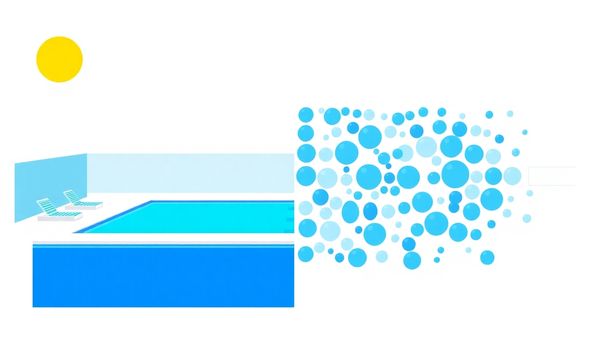
In the world of pool maintenance, calcium hypochlorite stands out as an unsung hero, quietly performing the heavy lifting to keep your swimming experience pristine. This humble compound, once known as "chloride of lime," has been busy battling bacteria since the 19th century. If you've ever wondered why your pool sparkles with clarity and freshness, you might owe a nod to the power packed in those granules.
Let's break it down. Created by mixing lime with chlorine gas, calcium hypochlorite is a potent sanitizing agent, known to contain between 65% to 75% chlorine. As it dissolves in your pool, it releases a surge of free chlorine, the active component that takes on any lurking germs or stubborn algae. By disrupting microbial cell functions, it makes quick work of bacteria, effectively sanitizing your pool.
Consider a typical evening scene when shadows lengthen and the sun dips below the horizon. This is the prime moment for your cal hypo to shine, as it thrives without sunlight's interference. By the time morning arrives, your pool is not just a body of water but a haven ready for your next dive.
Regular shocking, preferably once a week, isn't just about clear water—it's about peace of mind. With calcium hypochlorite, you're not merely maintaining a pool; you're ensuring a sanctuary of health and happiness for every swimmer who takes the plunge.
Harnessing the benefits of calcium hypochlorite is like unlocking a secret weapon in the battle against pool contaminants. The power of this compound starts with its high concentration of chlorine, ranging from 65% to 75%, which acts swiftly to neutralize bacteria and algae. Imagine the satisfaction of knowing your pool is not only clear but free from harmful microorganisms, all thanks to this potent chemical.
From a practical standpoint, calcium hypochlorite makes pool maintenance incredibly straightforward. It dissolves quickly and works effectively, meaning less waiting around for results. Just add it at dusk, and by morning, your pool is ready for action. There's a peace of mind that comes with understanding that the water your friends and family swim in is not only visually inviting but also safe.
Calcium hypochlorite also prevents those pesky chloramines, the culprits behind the classic "pool smell" and eye irritation. Regular shocking with cal hypo transforms these bonded compounds, releasing trapped chlorine and restoring its sanitizing power. It's like having a clean slate, every week.
Embracing calcium hypochlorite for pool shocking is more than just a maintenance task; it's a commitment to a healthier swimming environment. By integrating it into your routine, you take charge of your pool's cleanliness, ensuring every dive is greeted with refreshingly clean water. Welcome to a world of carefree swimming.
There’s a certain rhythm to mastering pool-shocking techniques with calcium hypochlorite, akin to learning the chords of a favorite song. This compound isn’t just a chemical; it’s the silent guardian of a clean pool, waiting for the cue to leap into action. As any seasoned pool owner will tell you, timing and preparation are everything.
First, consider the moonlit timing. Just as a seasoned chef knows the ideal moment to add spices, adding calcium hypochlorite at dusk ensures its maximum potency. The absence of sunlight prevents the chlorine from dissipating, allowing it to work its magic undisturbed through the night. By morning, your pool is primed for a chlorine-rich day, ready to fend off unwelcome intruders like bacteria and algae.
Preparation starts with a clear understanding of your pool’s needs. While a simple calculation might seem daunting, think of it as a recipe adjustment before the grand feast. Whether you’re using a manufacturer’s guide or rolling up your sleeves for some arithmetic, ensure you're adding the right amount. For instance, a 50,000-gallon pool with a TC of 2.5 might require around 7.4 pounds of cal hypo to hit that sweet spot.
Finally, remember the tools of the trade. The scoop, the protective gloves, and perhaps a stirring implement are your allies. Consistency is key; integrate this into your weekly routine and watch as your pool, much like a well-tended garden, thrives under your care. With a little patience and precision, the art of pool shocking becomes second nature, turning your backyard into an aquatic sanctuary.
Owning a pool is like hosting a never-ending party, with algae and bacteria as unwelcome guests. These tiny invaders thrive in warm, stagnant water, turning your sparkling oasis into a murky mess. Thankfully, calcium hypochlorite is the superhero your pool desperately needs. With its potent chlorine content, cal hypo targets and obliterates these pesky intruders, ensuring that each splash is both refreshing and safe.
A friend of mine once struggled with recurring algae blooms, a stubborn foe that seemed impossible to conquer. She tried everything, from algaecides to constant brushing, but nothing worked until she introduced calcium hypochlorite into her pool care routine. Within days, her pool transformed from an algae haven to a crystal-clear retreat. Regular shocking with cal hypo breaks down the molecular defenses of algae and bacteria, rendering them helpless.
Avoiding chloramine buildup is essential, and cal hypo tackles this issue head-on by releasing free chlorine into the water. This proactive approach not only eliminates harmful bacteria and algae but also neutralizes chloramines that cause irritation and that infamous “pool smell.” By regularly shocking your pool, you're setting a trap for unwanted microorganisms, ensuring they never get too comfortable. Embrace the power of calcium hypochlorite, and reclaim your pool from the microscopic menaces lurking beneath the surface.
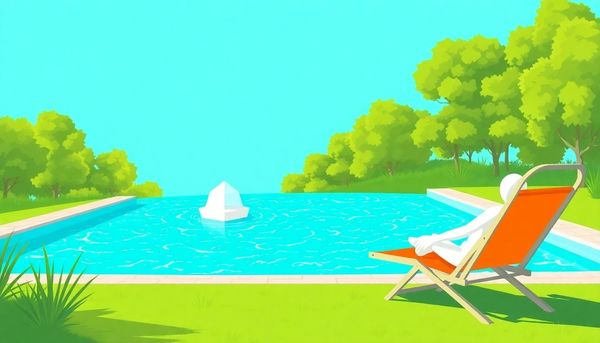
In the world of pool maintenance, calcium hypochlorite stands as a steadfast ally. Its roots trace back to times when cleanliness was a luxury, making waves in water sanitation since the 19th century. Today, this potent compound is the secret weapon in your pool care arsenal, tackling everything from murky waters to stubborn algae blooms with remarkable efficiency.
Think of calcium hypochlorite as the pool party's unsung hero, quietly ensuring that the water remains pristine long after the last swimmer has left. Its granular form makes it easy to handle, while its high chlorine content—often between 65% and 75%—ensures that bacteria and other unwanted guests don't overstay their welcome. This chemical marvel doesn’t just stop at purifying your pool; it also makes sure the calcium levels are perfectly balanced, which is crucial if you want to avoid scaling issues.
For those who prefer a hands-on approach, the math behind dosing might seem daunting, yet it’s incredibly rewarding. Calculating the precise amount needed ensures not only optimal cleanliness but also the safety of everyone diving in. After dark is the ideal time to introduce calcium hypochlorite, letting it work its magic overnight without the sun’s interference.
By embracing calcium hypochlorite in your pool maintenance routine, you're investing in peace of mind. With regular use, your pool becomes a haven of clear, clean water, inviting you to relax and enjoy without a second thought. So, dive in with confidence, knowing that behind every splash, there's a silent guardian keeping things just right.
Harnessing the full potential of calcium hypochlorite is not just about understanding its chemical prowess—it's about weaving it seamlessly into your pool maintenance routine to achieve peak sanitization efficiency. First, set the stage by prepping your pool. Clear out debris and check your pool’s pH levels to ensure they fall between 7.2 and 7.6. This range optimizes the effectiveness of calcium hypochlorite, allowing it to target contaminants with surgical precision.
Consider the timing—adding cal hypo at dusk is not just a quirky vampire reference. This strategy guards against UV rays that can diminish its effectiveness. Letting it work overnight ensures you wake to a pristine pool. Personally, I remember switching to nighttime treatments and noticing not just clearer water, but also a reduction in chlorine odor.
While measuring the right amount might seem daunting, think of it as a science experiment with a splash of poolside fun. Whether you’re a math whiz or more of a set-it-and-forget-it type, understanding your pool’s chlorine demand pays dividends. Keep a log of your pool’s total and free chlorine levels. This practice helps you anticipate when extra shock might be needed, such as after a pool party or heavy rainfall.
Incorporating calcium hypochlorite effectively ensures your pool isn’t just clean, it’s inviting. Embrace the routine, and you’ll transform maintenance into a smooth operation, leaving more time for those cherished summer swims.
Storing calcium hypochlorite properly is not just a suggestion; it’s a necessity for any pool owner wanting to maintain safety and efficiency. Whether you’ve just picked up a fresh batch from your local pool supply store or ordered online, the way you store this potent chemical can significantly impact its effectiveness and your safety.
Firstly, always ensure that calcium hypochlorite is kept in a cool, dry, and well-ventilated area. Moisture is its arch-nemesis, often leading to clumping or even hazardous chemical reactions. Remember that time your basement got a little damp, and your board games turned into mush? Picture something a lot more volatile happening with this chemical.
Avoid storing it near any organic materials or other pool chemicals, especially acids, as accidental contact can cause dangerous reactions. That incident when you accidentally left your grocery bag too close to the radiator—think much worse than melted chocolate.
Additionally, keep it out of reach of children and pets. You wouldn’t let your toddler near a stack of precious vinyl records, so exercise the same caution here. Opt for airtight, original containers, preferably those with child-proof caps, and label all containers clearly to prevent any mix-ups.
By taking these steps, your calcium hypochlorite will remain effective, ready for action when your pool needs a refreshing shock. This ensures not only a cleaner pool but also peace of mind, knowing you've minimized safety risks around your home.
Amidst the hustle and bustle of modern life, maintaining a pristine pool can feel like a small victory. For those keen to keep their aquatic oasis in tip-top shape, optimizing your calcium hypochlorite pool-shocking routine can be the golden ticket. Begin by assessing your pool's situation: does it endure heavy use, see a lot of debris, or bask under relentless sunlight? These factors can significantly impact how often you need to shock.
Instead of sticking to a rigid schedule, listen to your pool's cues. For instance, if you notice a hint of that familiar "pool smell" or the water appears cloudy, it's time to act. Conduct a quick test to check the free chlorine levels. Should the reading fall below the recommended range, it’s time to bring out your calcium hypochlorite.
When it comes to application, timing is crucial. Adding calcium hypochlorite after the sun sets reduces chlorine burn-off, allowing the compound to work its magic overnight. Always ensure the pool pump is running to circulate the water effectively. Remember that safety comes first; don protective gear and avoid handling the product with bare hands.
Lastly, consider the weather. Rain can dilute the chemical concentration, rendering your efforts less effective. Monitor forecasts and choose dry evenings for shocking. By fine-tuning your approach and responding to your pool's needs, you ensure a sparkling, inviting swim every time.
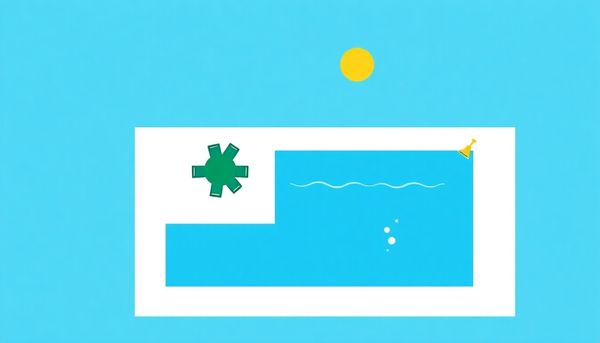
In the realm of pool maintenance, selecting the right shock treatment is akin to choosing the perfect tool for a job. Calcium hypochlorite stands out as the ideal solution for a multitude of reasons. It isn’t just about its potent ability to sanitize—though that’s undeniably a major perk—but also its ease of use and reliability that make it a favorite among pool owners.
Consider this: on a sunny Saturday afternoon, a pool full of splashing kids and sunbathers can quickly become a breeding ground for bacteria without proper care. This is where calcium hypochlorite shines. Unlike stabilized chlorines, its unstabilized form means it works best after the sun dips below the horizon, allowing it to tackle contaminants without interference from UV rays. Simply tossing it into the pool at dusk allows for overnight transformation, ensuring a crisp, clean swim by morning.
Another feather in its cap is its straightforward storage and application. Coming in a granulated form, it’s easy to handle and measure, making it accessible for even the most novice of pool caretakers. Couple that with its cost-effectiveness and the fact that it doesn’t require complex calculations for dosage—just a quick peek at the package instructions—and it becomes clear why cal hypo is the go-to choice.
When it comes to maintaining your pool's sparkling clarity and safety, calcium hypochlorite offers both peace of mind and simplicity, proving that sometimes, the classics truly are the best.
Every swimming pool owner knows the value of clear, clean water. And, just like a well-kept secret, calcium hypochlorite quietly stands as a hero among pool sanitizers. While you may know it as a reliable pool shock, its benefits extend far beyond simple sanitation.
First off, it's a powerhouse when it comes to disinfection. Containing a high percentage of chlorine — typically between 65% to 75% — calcium hypochlorite is adept at obliterating bacteria, algae, and other pesky contaminants. Its swift action and ability to dissolve quickly mean you can enjoy a safer swim faster than with many alternatives. Picture your regular pool session, minus the unwanted guests like bacteria and algae, thanks to this compound.
Another often-overlooked benefit is its role in maintaining water balance. Calcium hypochlorite doesn’t just sanitize; it also contributes a modest amount of calcium to the water, which can be crucial for keeping the pool’s calcium hardness in check. This aspect is particularly beneficial for owners managing softer water conditions or combating corrosive tendencies that can damage pool surfaces or equipment over time.
Beyond the chemistry, it’s the convenience of calcium hypochlorite that wins the day. With its long shelf life and ease of storage, you aren't just investing in a cleaner pool — you're also choosing a user-friendly solution that fits seamlessly into your routine. So, when it's time to shock your pool, you can do so with confidence, knowing you've chosen a tried-and-true champion of clarity and cleanliness.
Mastering the art of pool shocking can transform an ordinary swim into a pristine experience, and the key lies in optimizing your calcium hypochlorite routine. Picture it like setting the perfect rhythm for a dance—too little, and the pool party falls flat; too much, and the next splash feels like stepping into a chemical soup. Here’s how to hit the sweet spot.
Begin by knowing your pool’s unique personality. Regularly test your water’s chlorine and pH levels. This isn't just maintenance; it's like checking the pulse of your pool. You'll want to aim for a free chlorine level between 1.0 and 3.0 ppm. If you find your pool frequently above or below this range, consider tweaking your shock frequency.
Timing is crucial. Remember, calcium hypochlorite is most effective when added in the evening. This ensures the sun’s rays won’t degrade its potency before it can do its work. Think of it as giving your pool a night shift of sanitation warriors, battling bacteria and algae while you sleep.
For those unplanned mishaps—like unexpected pool parties or an accidental leafy invasion—don't hesitate to give your pool an extra shock. It's like a surprise power boost when your pool needs it the most.
Combine these strategies with consistent monitoring, and your pool will not only look inviting but will remain a safe oasis all summer long. You’ll soon find yourself spending more time enjoying your oasis, and less time stressing over maintenance.
There's a certain thrill in mastering the art of pool maintenance, especially when it involves wielding the potent power of calcium hypochlorite. Known affectionately as cal hypo, this compound offers a dynamic solution to pool owners dedicated to pristine waters. With its origins as a staple in water sanitation since the 19th century, cal hypo remains a top choice for pool shock today, renowned for its efficiency in eradicating bacteria and algae.
Understanding the nuances of cal hypo usage can elevate your pool care game. First, timing is everything. Adding cal hypo at dusk minimizes its interaction with sunlight, preserving its disinfecting potential. This simple adjustment lets you wake up to a sparkling pool without losing effectiveness to the sun's rays.
Moreover, regularity is key. Establishing a schedule—ideally weekly—keeps chloramines at bay, those pesky compounds that not only dull the water but pose health risks like skin irritation and respiratory issues. In instances of heavy use or accidental contamination, such as bathroom-related mishaps, a more frequent shock might be necessary.
For the best results, always measure your pool’s current chlorine levels and adjust the dosage accordingly. Whether you're calculating it yourself or following the manufacturer’s guide, knowing the right amount of cal hypo ensures optimal sanitation without overspending your resources.
Incorporating these techniques into your routine transforms pool maintenance from a chore into a craft. With each use, cal hypo proves itself not just as a tool, but a trusty ally in maintaining a clean and inviting aquatic escape.
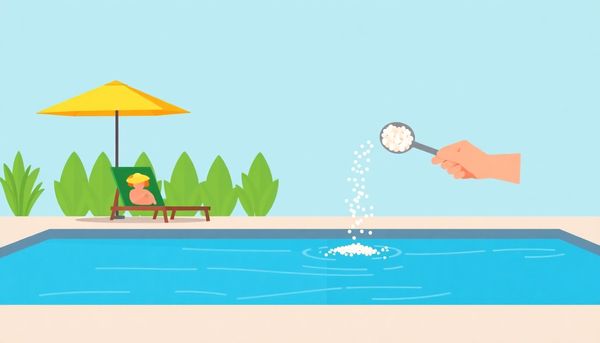
You know that moment when you dive into your pool and feel the crisp, clean water envelop you? That's not just a happy coincidence—it's the magic of calcium hypochlorite, or cal hypo, at work. This chemical is not just any pool shock; it's a guardian against the lurking threats of bacteria and algae. With its rich history in water sanitization, cal hypo has proven itself as a reliable ally for pool owners who want nothing but the best for their backyard oasis.
Consider cal hypo not just a maintenance tool, but a pool party hero. Its strong chlorine content, typically between 65-75%, ensures your pool remains a fresh, inviting blue. Beyond its disinfecting abilities, cal hypo contributes about 0.8 ppm of calcium each time it adds 1 ppm of free chlorine. This balances the water chemistry while ensuring no microscopic nasties ruin your swim time. However, do keep an eye on calcium levels to avoid scaling.
Addressing the chemistry behind cal hypo, its unstabilized chlorine is most effective when the sun has set. Add it at dusk, and let it work its night-shift magic. By morning, your pool will be a sparkling haven, free from chloramines and their irritating, telltale odors. Regular shocking with cal hypo doesn't just maintain sanitation; it elevates your pool's health, ensuring you can dive in without a worry.
In the realm of pool maintenance, calcium hypochlorite stands out not just as a mere chemical but as a guardian ensuring crystal-clear waters. This unsung hero, often just another name on a chemical list, carries within it the legacy of over a century of water sanitation. Its origins trace back to when it was first lauded for its ability to purify drinking water. For modern pool owners, cal hypo serves as a robust solution to the myriad of contaminants that attempt to invade our aquatic retreats.
To appreciate its benefits, consider its dual role. Not only does it act as a potent disinfectant, but it also plays a crucial part in balancing your pool's chemistry. Each dose introduces a calculated amount of calcium, which helps reinforce your pool’s structure, ensuring the longevity of your plaster and tiles. This symbiotic relationship between sanitation and structural integrity is unique to cal hypo and often overlooked.
Using cal hypo isn’t just about routine; it’s about proactive pool care. By regularly shocking your pool with this compound, you combat the invisible foes like bacteria and algae before they become visible nuisances. Think of it as a preventative measure rather than a reactive one, saving you headaches and potential health risks in the long run.
The simplicity of its application—swiftly dissolving and acting during nighttime hours—makes it an accessible choice for all pool owners. By bringing cal hypo into your maintenance routine, you’re not just adding a chemical; you’re investing in peace of mind, ensuring that every swim is as refreshing as the first.
Timing your pool shock with calcium hypochlorite is akin to finding the perfect moment to unveil a surprise at a party—it can transform an ordinary evening into something spectacular. The trick lies in choosing the right time to unleash its potent sanitizing powers. Use it at dusk or during the quiet of night when the sun’s rays can’t burn off the chlorine before it can do its magic. This ensures that the maximum amount of chlorine is available to combat bacteria and algae, leaving the water pristine by morning.
Think about your pool’s daily rhythm. After a weekend of splashing and laughter, it’s prime time for a shock treatment. The accumulated organic contaminants will need a strong response, and calcium hypochlorite is eager to oblige. During the week, a regular schedule might involve a mid-week shock to handle unexpected challenges like storms or extra pool parties.
Remember, temperature and usage can also dictate timing. In the heat of summer, when the pool is in constant use, more frequent shocks might be necessary. Cooler months may allow for a more relaxed schedule. By aligning your shocking routine with your pool’s unique lifestyle, you ensure that every swim is as refreshing and clean as possible. Embrace the rhythm of your pool, and calcium hypochlorite will never let you down.
There's a hidden menace in your pool that can turn a refreshing swim into an irritating experience—chloramines. These pesky chemicals emerge when chlorine binds with organic matter like sweat or leaves, forming compounds that not only trap chlorine but also release that unmistakable "pool smell." They can be as bothersome as an unexpected sunburn, causing eye and skin irritation, and even respiratory issues for some swimmers.
Enter calcium hypochlorite, your pool's unsung hero. This formidable compound doesn’t just elevate your pool’s free chlorine levels; it launches a direct assault on chloramines, breaking their bonds and freeing the captured chlorine. This makes the chlorine available again to sanitize effectively. It's like giving your chlorine a second chance to shine and do its job properly.
Back in my college days, when I was the designated pool manager at the community center, we swore by calcium hypochlorite for our weekly shocks. I remember one summer, we faced an onslaught of chloramines after a particularly busy weekend. The air was thick with that familiar acrid smell, and swimmers complained of stinging eyes. A generous dose of cal hypo overnight turned things around by morning; the water was crystal clear, and the air above the pool was fresh once again.
Regular shocking, especially with calcium hypochlorite, ensures chloramines don’t get a foothold. Consider it your pool’s weekly cleansing ritual—a commitment to keeping the water inviting and the swim experience delightful. Adjust the frequency based on use and environmental factors, and your pool will thank you for it.
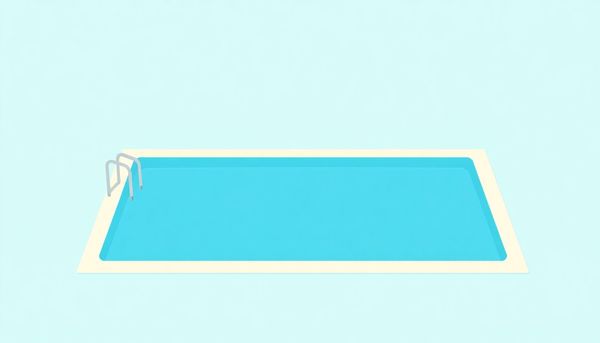
When it comes to maintaining a pristine swimming pool, calcium hypochlorite is your secret weapon against unwelcome intruders like bacteria and algae. Remember last summer's pool party where you noticed the water had become slightly murky after a few hours? That's a sign organic contaminants are making themselves at home, and that's where calcium hypochlorite shines. Unlike other sanitizers, its powerful chlorine content acts swiftly, targeting and neutralizing these invaders with precision.
Starting your pool treatment routine with calcium hypochlorite isn't just about immediate results—it's also about prevention. Regular shocking can transform your pool into an unwelcoming environment for contaminants. Algae blooms, for instance, can turn a beautiful swimming area into a green nightmare in no time. Yet, with a consistent shock schedule, those pesky spores don't stand a chance.
Moreover, this compound's knack for eradicating chloramines pays dividends beyond clear water. Chloramines are the culprits behind that strong "pool smell" and can even cause eye irritation. By breaking them down, calcium hypochlorite ensures not just clarity but comfort for swimmers. Just like a reliable lifeguard, it watches over your pool’s health, ensuring each dip is fresh and inviting. Next time you gear up for maintenance, trust in calcium hypochlorite to guard your aquatic oasis, leaving you more time to enjoy those sun-soaked afternoons beside the water.
Taming the wild waters of your pool requires more than just a casual sprinkle of chemicals. Calcium hypochlorite, affectionately known as cal hypo, is a pool owner’s secret weapon. Imagine taking a tactical approach to pool maintenance: with a little know-how, this potent compound can become your trusted ally in maintaining pristine water.
First, ensure you have the right tools. A reliable water testing kit is essential. It guides you in understanding your pool’s current chemical balance and determining the precise amount of cal hypo needed. For instance, if your pool's total chlorine is low, you'll need to calculate the precise amount of cal hypo to add based on your pool’s volume and current free chlorine levels. Remember, for every 1 ppm of free chlorine you wish to add, you'll generally need two ounces of cal hypo per 10,000 gallons of water.
Timing is just as crucial. Adding cal hypo at dusk ensures its chlorine content isn’t wasted by the sun’s UV rays. This allows the chlorine to work its magic overnight, leaving your pool refreshed by morning. Agitating the water, perhaps by running your pool pump, helps the chemical distribute evenly, ensuring no corner is left unprotected.
Ultimately, consistent use of calcium hypochlorite not only rids your pool of pesky chloramines but also fortifies it against future invasions. With a bit of planning and regular attention, cal hypo transforms pool maintenance from a chore into a seamless part of enjoying your backyard oasis.
Underneath the surface of your shimmering pool lies a battleground. On one side, there’s the algae—a relentless green force that can turn any pool party into a swampy saga. On the other, bacteria, invisible yet formidable foes, ready to spoil the fun with their microscopic mischief. Luckily for pool owners, calcium hypochlorite stands as a staunch ally in this aquatic warfare.
This chemical powerhouse doesn't simply sit idly by. It leaps into action, using its high chlorine content to obliterate algae and bacteria with precision. Essentially, calcium hypochlorite releases chlorine, which breaks down the cell walls of these pesky organisms, dismantling them from the inside out. This process ensures that the water stays clear, safe, and as inviting as the idea of a lazy Sunday afternoon float.
The beauty of calcium hypochlorite lies not just in its effectiveness but also in its speed. Unlike some other treatments, it acts swiftly, giving you peace of mind and a pristine swim the very next day. And because it’s unstabilized, it’s best applied during the evening hours. This timing allows it to work its magic uninterrupted by the sun’s rays.
For anyone keen on keeping their pool pristine without constant fretting, integrating calcium hypochlorite into a regular maintenance routine is a game-changer. It’s like having a secret weapon in your pool care arsenal—a guarantee that every dive is a clean, refreshing one.
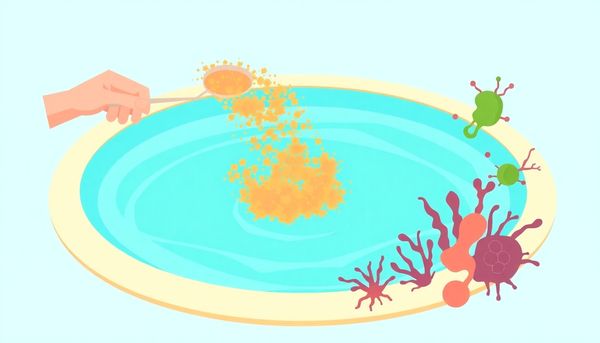
This article provided insights into maintaining your pool. Start your pool care journey today!
Want to become a pool maintenance expert? Our free Pool School course covers everything you need to know about pool care. From basic maintenance to advanced troubleshooting, you'll learn how to:
Join over 10,000 pool owners who have already transformed their pool care routine. Get started with our free Pool School course today!